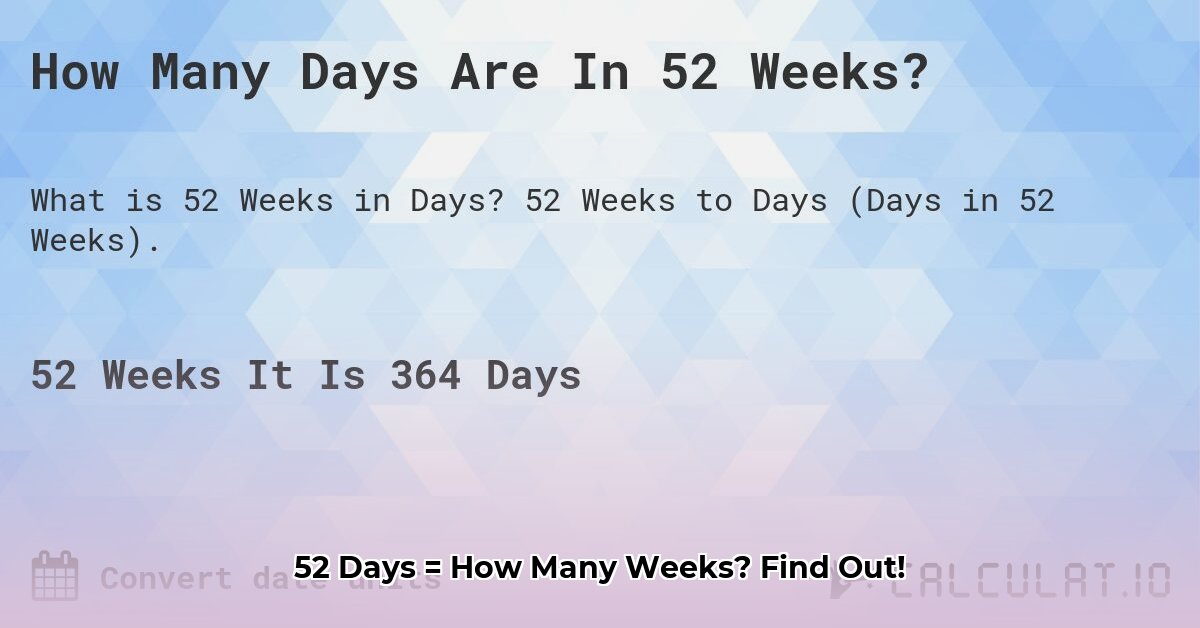
Ever need to quickly figure out how many weeks are in a specific number of days? While seemingly simple, accurately converting days to weeks requires attention to detail, especially when dealing with longer periods or needing precise results. For more complex conversions, check out this helpful days to hours converter. This guide provides a straightforward, step-by-step method, highlighting different approaches and addressing potential pitfalls like leap years.
Understanding the Fundamentals: Days and Weeks
The foundation of our conversion rests on the simple fact: a standard week consists of seven days. This means to convert any number of days into weeks, we fundamentally divide the total number of days by seven.
Let's illustrate with a quick example. If you have 14 days, dividing 14 by 7 yields 2 weeks. This is the basic principle behind our conversion process.
Calculating Weeks in 52 Days: A Practical Example
Now, let's apply this to our central question: converting 52 days into weeks. The calculation is straightforward: 52 days / 7 days/week. A standard calculator will give you 7.43 weeks.
This result, 7.43 weeks, indicates 7 full weeks and a fraction of a week. The decimal portion represents the "remainder"—the days that don't constitute a complete week.
Deciphering the Remainder: Understanding Decimal Results
The decimal part of our result (.43 in this instance) signifies the portion of a week remaining. To calculate the remaining days, simply multiply the decimal portion by 7 (the number of days in a week). In our example: 0.43 weeks * 7 days/week ≈ 3 days.
Therefore, 52 days is equivalent to 7 weeks and 3 days. Alternatively, you can express the result as 7.43 weeks, depending on the level of precision required for your specific application.
Diverse Approaches to Day-to-Week Conversion
Several methods can facilitate this conversion, each offering different levels of precision:
Direct Division: The most straightforward method involves directly dividing the total number of days by 7 (days/week). This provides both whole weeks and the remaining fraction of a week.
Integer Division (Focusing on Whole Weeks): If you primarily need the total number of complete weeks, ignore the decimal portion after division. For 52 days, this would result in 7 weeks.
Calculator Utilization: A calculator simplifies the process, providing both the whole number of weeks and the decimal representing the remaining fraction of a week. Most modern smartphones include built-in calculators.
The Significance of Precision: Contextual Considerations
Choosing the appropriate method depends heavily on the context. For many everyday situations, knowing that 52 days is approximately 7 weeks suffices. However, in situations demanding greater accuracy, such as project scheduling or financial calculations, including the remainder (the extra days) is crucial. Imagine you are planning a 52-day project: knowing it's slightly longer than 7 weeks, by about 3 days, helps you adjust scheduling and resource allocation.
Long-Term Calculations: Incorporating Leap Years
When working with extended periods, especially those spanning several years, the influence of leap years becomes significant. Leap years, occurring every four years (with exceptions for century years not divisible by 400), contain 366 days instead of the usual 365. This additional day impacts the accuracy of our simple day-to-week conversion.
To maintain accuracy over longer periods, integrate the extra days contributed by leap years during your conversion calculation. This requires determining the number of leap years within the timeframe and adjusting the total number of days accordingly before dividing by 7. For extremely lengthy periods, specialized date calculators or spreadsheet software are recommended for precise calculations.
Practical Applications and Real-World Examples
The ability to convert days to weeks finds application across various domains:
- Project Management: Estimating project durations and creating timelines.
- Event Planning: Determining event lengths and scheduling related activities.
- Payroll: Calculating weekly wages based on daily earnings.
- Education: Teaching fundamental mathematical operations and time management skills.
Mastering this basic conversion enhances organizational skills and facilitates efficient planning across numerous scenarios.
Conclusion: Mastering Day-to-Week Conversions
Converting days to weeks is a simple yet valuable skill. While basic division serves adequately for many cases, understanding the nuances of handling remainders and accounting for leap years for extended periods ensures accuracy in all applications. By employing the methods outlined above and recognizing potential sources of inaccuracy, you can confidently perform precise conversions and apply results effectively across a multitude of situations.